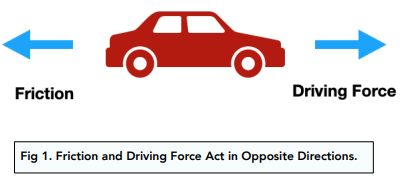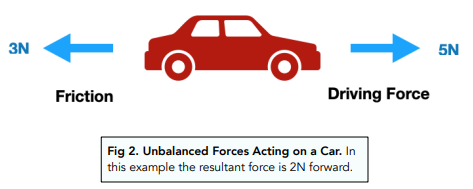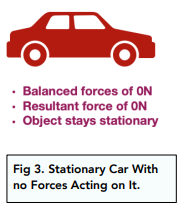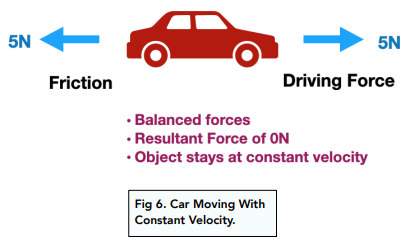Newton's First Law (GCSE Physics)
Newton’s First Law
Balanced and Unbalanced Forces
- Forces can act on both stationary and moving objects. Sometimes these forces act in opposite directions – for example, a car engine drives the car forward, whilst friction opposes this and pushes against the car in the opposite direction.

- Sometimes the forces acting on objects can be balanced (they equal each other) or unbalanced. If forces are unbalanced, we can calculate the resultant force in a particular direction.

Newton’s First Law
The first law to learn is Newton’s First Law.

This law might not make too much sense to you, so let us break it down. The law is telling us that:
- If the forces on an object are balanced, its speed will not change. If it is stationary (speed = 0), then it will stay stationary. If it is travelling at 4km/h, it will stay at 4km/h.
- If the forces acting on an object are unbalanced, its speed will change. The object will accelerate or decelerate depending on the direction of forces.
- For a stationary object, a resultant force can only cause acceleration (you can’t slow down from 0!).
- For a moving object, a resultant force will cause acceleration if its in the direction of movement, or deceleration if its against the direction of movement.
Applying Newton’s First Law
We will look at stationary and moving objects in more detail in the following scenario:
1. Stationary Object – there are no forces acting on this stationary object. The resultant force is zero and the car is stationary:

2. Stationary Object – Tom tries to push his car, but it doesn’t move. This is because the force of his push does not exceed the force of friction pushing the other way. The resultant force is still zero and the car remains stationary.
3. Moving, Accelerating Object – Tom starts the engine, and the driving force of the car now exceeds friction. The car starts to accelerate because there is a resultant force. The speed is increasing (starting from 0 km/h at rest).

4. Moving, Constant Velocity Object – the force of friction increases and catches up, and now equals the driving force. There is no resultant force, so the object is no longer changing speed (no acceleration). However, it is not stationary either – it is at constant velocity.

Inertia
We can sum up Newton’s First Law using one word, ‘inertia’. This describes what happens to both moving and stationary objects.
We can use inertia to describe the unchanged motion of objects. In the previous section, we mentioned the motion of vehicles when no resultant force is applied. The concept of inertia is the tendency for these objects to continue in their state of rest or uniform motion.





Still got a question? Leave a comment
Leave a comment